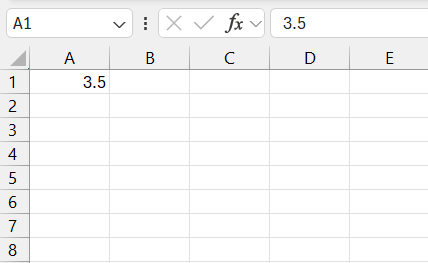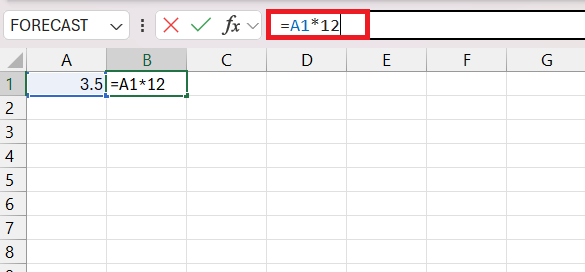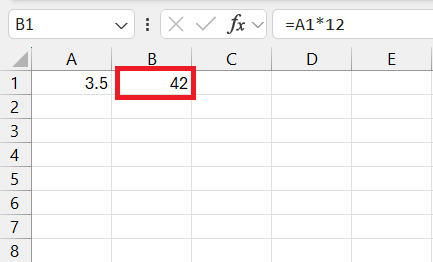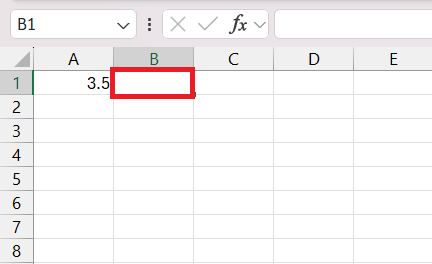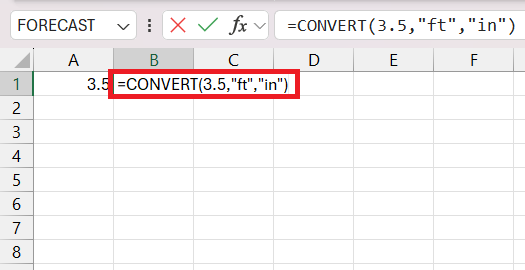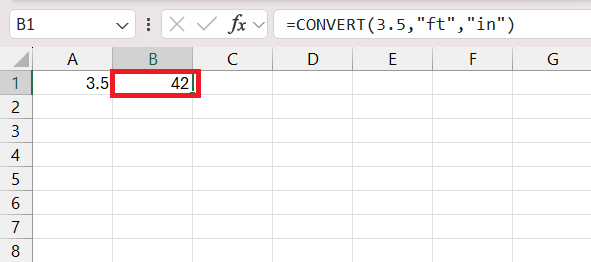Converting feet to inches in Microsoft Excel is a straightforward process that can be achieved with simple multiplication. To transform a measurement from 3.5 feet to inches, you’ll need to multiply the feet value by the conversion factor of 12, as one foot is equivalent to 12 inches. This quick calculation can assist you in obtaining accurate measurements in inches within the versatile environment of Excel spreadsheets.
Key Takeaways
- Converting feet to inches provides finer resolution, ensuring accuracy in dimensions.
- Converting feet to inches in Excel involves straightforward multiplication. With a fixed conversion factor of 12, the formula =A1*12 can be applied.
- Excel’s CONVERT function is designed for unit conversion, offering a structured approach.
- Leveraging Excel for unit conversion provides time efficiency, accuracy, reusability, flexibility, and integration capabilities.
Download the workbook and follow along the tutorial on how to convert 3.5 ft to inches in Excel – Download excel workbook3.5-ft-to-inches-in-Excel.xlsx
Table of Contents
Unraveling the Conversion Mystery
Why Convert Feet to Inches?
Feet and inches are popular units of measurement, especially in the United States and the United Kingdom. For various projects—be it construction, art, or even simple school assignments—precise measurements are key. Inches offer a finer resolution than feet when you need exact dimensions, making conversions from feet to inches a common necessity for detailed accuracy.
Understanding the Basics of Length Units
Before diving into conversion techniques, it’s essential to grasp the fundamentals of length units. The inch is a standard unit of length in the US Customary Units and British Imperial Units systems. One inch is defined as 1/12 of a foot, and therefore, 1/36 of a yard. According to the modern definition, an inch is exactly 25.4 millimeters.
Inches are often the preferred unit of measurement for the dimensions of various items and structures, such as furniture, electronic screens, clothing, paper sizes, and building materials. Transitioning between different units of length is crucial in various fields to accommodate international standards or personal preferences.
In a broader context, units of length can range from miles, yards, and feet to inches on the imperial side and kilometers, meters, centimeters, and millimeters on the metric side. This guide focuses on converting feet to inches, creating a common ground for various applications.
Step-by-Step Conversion Process
Simple Multiplication
Converting a specific measurement such as 3.5 feet to inches in Excel requires the creation and use of a straightforward formula. Since one foot equals 12 inches, the conversion from feet to inches can be accomplished by multiplying the number of feet by 12. Here’s how to do it:
STEP 1: Enter the value 3.5 in a cell (A1, for instance).
STEP 2: In the adjacent cell (B1), enter the formula =A1*12. This will multiply the number of feet in A1 by 12 to give you the equivalent number of inches.
STEP 3: Upon pressing Enter, cell B1 will display 42, which is the result of the conversion (3.5 feet is equal to 42 inches).
Remember, this formula relies on the fixed conversion factor between feet and inches which is 12. For any value in feet that you wish to convert to inches, replace 3.5 with your specific number and use the same multiplication formula.
Given that you might want to convert several different measurements at once, you could set up a range of feet values in column A and drag the formula down in column B to get the equivalent inches for each measurement automatically. Excel will adjust the cell references accordingly.
By consistently using formulas, Excel allows for quick and easy repetitions of this conversion process without the need for complex programming or additional software.
CONVERT function
The CONVERT function is specifically designed for unit conversion. The syntax for the CONVERT function is CONVERT(number, "from_unit", "to_unit"), where number is the value to be converted, and from_unit and to_unit are the current and desired units, respectively.
Follow the steps below to convert 3.5 Feet to Inches Using the CONVERT Function in Excel:
STEP 1: Click on a cell where you want to display the converted measurement. This will be the cell where the result in inches will appear.
STEP 2: Type the following formula into the selected cell:
=CONVERT(3.5,”ft”,”in”)
Explanation of formula components:
- `=CONVERT(` initiates the use of the CONVERT function.
- `3.5` is the value in feet that you want to convert to inches.
- `”ft”` is the unit of the number you want to convert from (feet).
- `”in”` is the unit you want to convert to (inches).
Upon hitting Enter, the cell will display the result of the conversion from feet to inches. According to the conversion factor where 1 foot is equal to 12 inches, the formula will multiply 3.5 feet by 12 to arrive at the equivalent measurement in inches.
Convert Inches to Feet and inches
To convert inches to feet and inches in Excel, you can follow these steps utilizing a combination of the INT and MOD functions:
STEP 1: Enter the inch measurements in the designated cell.
STEP 2: Go to cell B2 and type the formula =INT(A1/12)&”‘”&MOD(A1,12)&””””
This formula uses the INT function to get the whole number of feet and the MOD function to get the remaining inches.
- INT(A2 / 12) calculates the whole number of feet.
- MOD(A2, 12) calculates the remaining inches after converting to feet.
- The formula concatenates the results with the foot and inch symbols (“‘” and “””).
Pro Tips and Tricks
Key Benefits of Using Excel for Unit Conversion
Leveraging Excel for unit conversion offers significant advantages that streamline and simplify the process. Here are the key benefits:
- Time Efficiency: Excel allows for rapid conversions without the need for manual calculations or separate tools. You can convert a large batch of measurements simultaneously.
- Accuracy: Given that Excel functions are thoroughly tested and standardized, the risk of errors in manual computations is greatly reduced.
- Reusability: Once you set up a conversion formula, it can be reused and adapted for different situations. This makes Excel particularly powerful for repetitive tasks.
- Flexibility: With Excel, you can easily perform conversions between a wide range of units and also create custom formulas for specific conversion factors.
- Integration: Excel’s conversion capabilities can be integrated into broader financial or data analysis tasks, aiding in more complex calculations that require unit measurements.
- Education: Using Excel for conversions can help users better understand the relationship between different units of measurement through visual representation.
By integrating unit conversion within Excel, you optimize the workflow and ensure consistent results across various applications.
Optimizing Your Conversion Approach for Speed and Accuracy
To optimize your unit conversions in Excel for both speed and accuracy, consider these strategies:
- Automation: Automate repetitive tasks by using the fill handle to copy conversion formulas down a column, or by employing tables that automatically expand formulas to new data entries.
- Named Ranges: Define named ranges for frequently used constants, such as the number of inches in a foot. This way, you can use a meaningful name in your formulas instead of hard-coding numbers, minimizing the potential for errors.
- Precision Formatting: Ensure that your cells are formatted to display the desired number of decimal places, maintaining a balance between precision and readability.
- Data Validation: Use data validation to restrict input to numerical values, preventing conversion errors due to improper data.
- Conditional Formatting: Apply conditional formatting to highlight unusual or unexpected results, which aids in quickly identifying potential errors.
- Error Checking: Regularly use Excel’s error-checking features to scan for common mistakes in formulas and data entry.
- Shortcuts and Quick Access Toolbar: Learn and use keyboard shortcuts for actions like copying, pasting, and formatting, and customize the Quick Access Toolbar with buttons for frequent commands.
- Macro Recording: For complex or multi-step conversions, consider recording a macro to automate the process, saving time and ensuring consistent application across datasets.
By incorporating these methodologies, you can enhance the efficiency and reliability of your unit conversions in Excel, leading to a streamlined experience that upholds the integrity of your data.
FAQs About Unit Conversion in Excel
How Do I Use the CONVERT Function for Feet to Inches?
To use the CONVERT function in Excel for converting feet to inches, you’ll need to specify the value in feet you want to convert, followed by the source unit “ft” for feet, and the target unit “in” for inches in the function’s arguments. For instance, if you have the measurement in cell A1, the formula to convert that measurement from feet to inches would be `=CONVERT(A1, “ft”, “in”)`.
Can I Convert Decimal Feet to Inches Easily?
Yes, converting decimal feet to inches in Excel is relatively straightforward. Since there are 12 inches in a foot, to convert decimal feet to inches, you simply multiply the decimal by 12.
John Michaloudis is a former accountant and finance analyst at General Electric, a Microsoft MVP since 2020, an Amazon #1 bestselling author of 4 Microsoft Excel books and teacher of Microsoft Excel & Office over at his flagship MyExcelOnline Academy Online Course.

